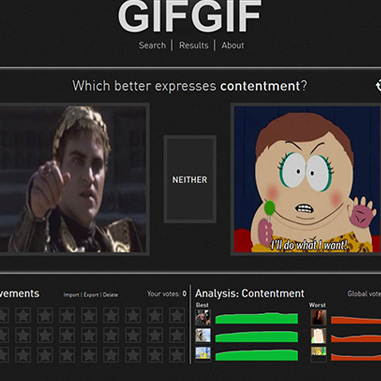MIT is attempting to prove that a properly placed GIF can accurately convey human emotion, through a new website GIFGIF. Travis Rich and Kevin Hu claim:
An animated gif is a magical thing. It contains the power to convey emotion, empathy, and context in a subtle way that text or emoticons simply can’t.
GIFGIF is a project to capture that magic with quantitative methods. Our goal is to create a tool that lets people explore the world of gifs by the emotions they evoke, rather than by manually entered tags.
Taking inspiration from the Place Pulse project, which uses a similar format to measure how people perceived different neighbourhoods (or photos of neighbourhoods), this projects asks viewers to choose between one of two GIFs based on which most accurately portrays a certain emotion.
Then each GIF is then ranked within the following 17 emotions: amusement, anger, contempt, contentment, disgust, embarrassment, excitement, fear, guilt, happiness, pleasure, pride relief, sadness, satisfaction, shame, and surprise. There is a results section where you can see the best (and worst) scoring emotion GIFs and, of course, use them.
The reason for the study, they explain, is to answer “some really interesting questions” like:
Does a gif’s emotional variance impact how it’s received? (We have a hunch that emotional variance is why :) is pretty acceptable but ;) is typically an awkward mix of creepy/sexy/playful/pirate-y). Does a gif’s emotional content vary between cultures? For example, what is the best representation of happiness for Germans, compared to a Canadian’s impression?
It’s pretty interesting to think that the internet has had this much impact on our emotional expression and understanding of it… and there are some pretty sweet GIFs to be seen as well.
Matt Derody
More GIF Stuff
GIF Recap: The 86th Academy Awards
The .GIFYs: an awards show celebrating the best .GIFs of 2013
Visual art: Zach Dougherty’s GIFs

